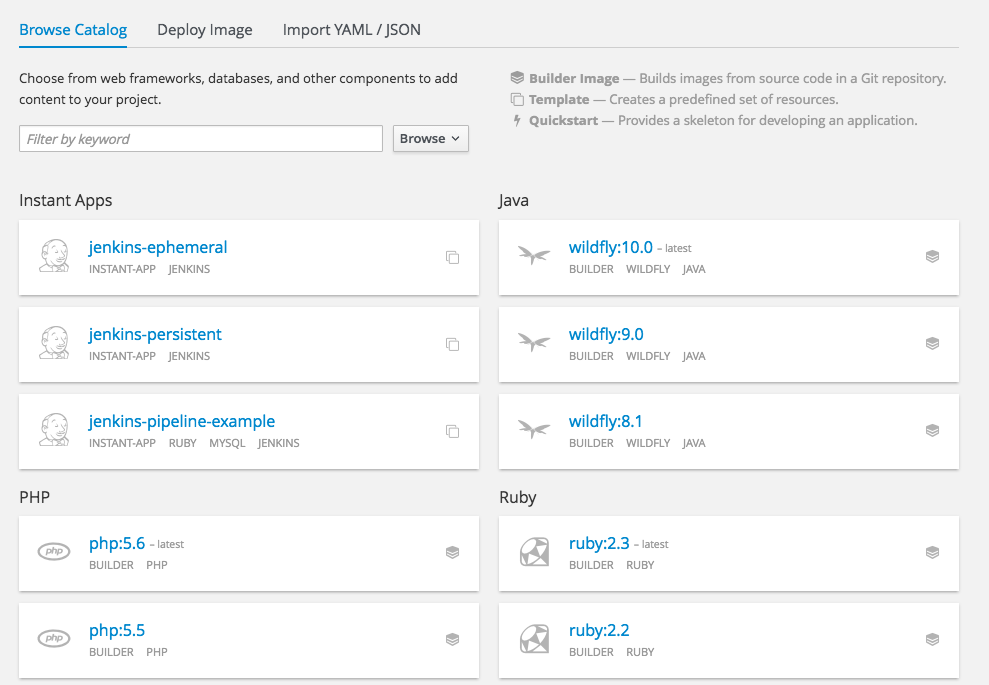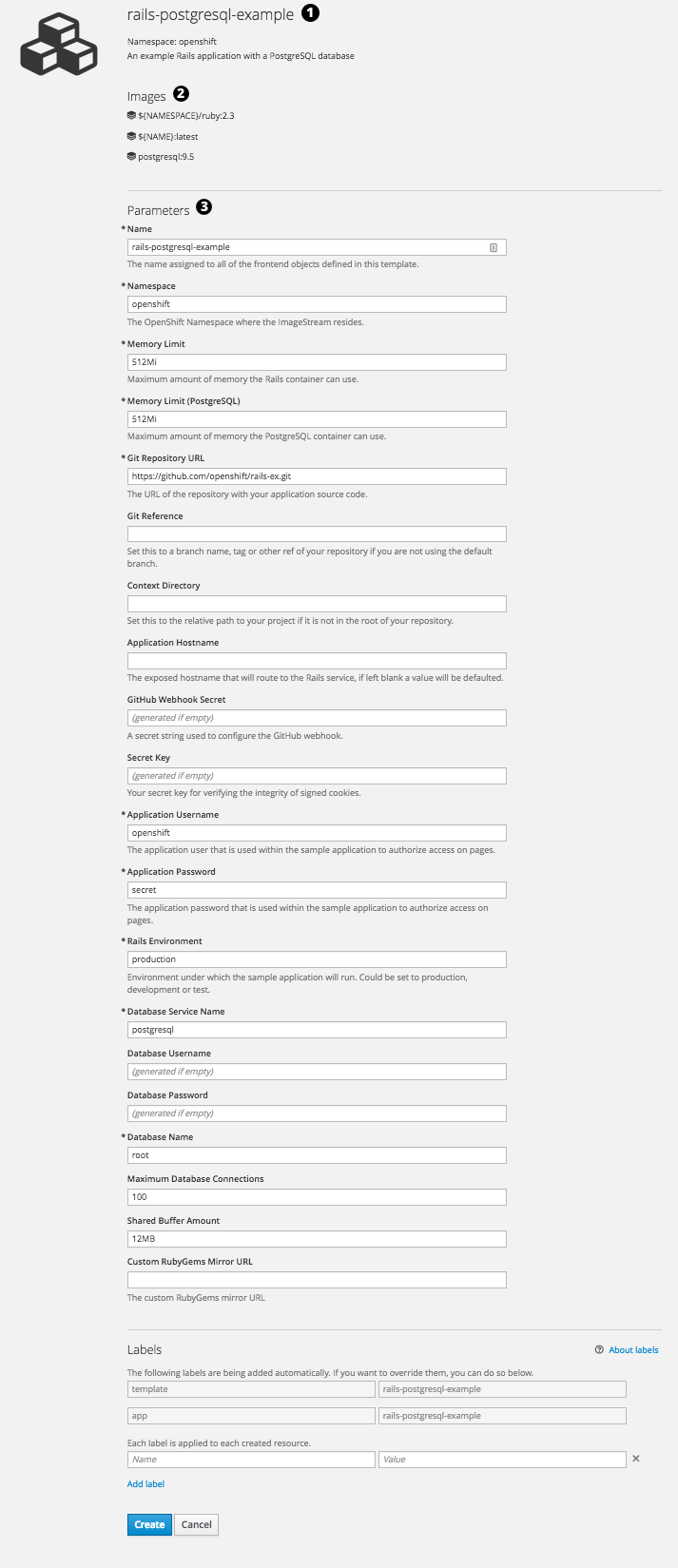This documentation is for a release that is no longer maintained
See documentation for the latest supported version 3 or the latest supported version 4.此内容没有您所选择的语言版本。
Chapter 8. Templates
8.1. Overview
A template describes a set of objects that can be parameterized and processed to produce a list of objects for creation by OpenShift Container Platform. A template can be processed to create anything you have permission to create within a project, for example services, build configurations, and deployment configurations. A template may also define a set of labels to apply to every object defined in the template.
You can create a list of objects from a template using the CLI or, if a template has been uploaded to your project or the global template library, using the web console.
8.2. Uploading a Template
If you have a JSON or YAML file that defines a template, for example as seen in this example, you can upload the template to projects using the CLI. This saves the template to the project for repeated use by any user with appropriate access to that project. Instructions on writing your own templates are provided later in this topic.
To upload a template to your current project’s template library, pass the JSON or YAML file with the following command:
oc create -f <filename>
$ oc create -f <filename>
You can upload a template to a different project using the -n option with the name of the project:
oc create -f <filename> -n <project>
$ oc create -f <filename> -n <project>The template is now available for selection using the web console or the CLI.
8.3. Creating from Templates Using the Web Console
To create the objects from an uploaded template using the web console:
While in the desired project, click Add to Project:
Select a template from the list of templates in your project, or provided by the global template library:
Modify template parameters in the template creation screen:
- Template name and description.
- Container images included in the template.
- Parameters defined by the template. You can edit values for parameters defined in the template here.
- Labels to assign to all items included in the template. You can add and edit labels for objects.
8.4. Creating from Templates Using the CLI
You can use the CLI to process templates and use the configuration that is generated to create objects.
8.4.1. Labels
Labels are used to manage and organize generated objects, such as pods. The labels specified in the template are applied to every object that is generated from the template.
There is also the ability to add labels in the template from the command line.
oc process -f <filename> -l name=otherLabel
$ oc process -f <filename> -l name=otherLabel8.4.2. Parameters
The list of parameters that you can override are listed in the parameters section of the template. You can list them with the CLI by using the following command and specifying the file to be used:
oc process --parameters -f <filename>
$ oc process --parameters -f <filename>Alternatively, if the template is already uploaded:
oc process --parameters -n <project> <template_name>
$ oc process --parameters -n <project> <template_name>For example, the following shows the output when listing the parameters for one of the Quickstart templates in the default openshift project:
The output identifies several parameters that are generated with a regular expression-like generator when the template is processed.
8.4.3. Generating a List of Objects
Using the CLI, you can process a file defining a template to return the list of objects to standard output:
oc process -f <filename>
$ oc process -f <filename>Alternatively, if the template has already been uploaded to the current project:
oc process <template_name>
$ oc process <template_name>
You can create objects from a template by processing the template and piping the output to oc create:
oc process -f <filename> | oc create -f -
$ oc process -f <filename> | oc create -f -Alternatively, if the template has already been uploaded to the current project:
oc process <template> | oc create -f -
$ oc process <template> | oc create -f -
You can override any parameter values defined in the file by adding the -v option followed by a comma-separated list of <name>=<value> pairs. A parameter reference may appear in any text field inside the template items.
For example, in the following the POSTGRESQL_USER and POSTGRESQL_DATABASE parameters of a template are overridden to output a configuration with customized environment variables:
Example 8.1. Creating a List of Objects from a Template
oc process -f my-rails-postgresql \
-v POSTGRESQL_USER=bob,POSTGRESQL_DATABASE=mydatabase
$ oc process -f my-rails-postgresql \
-v POSTGRESQL_USER=bob,POSTGRESQL_DATABASE=mydatabase
The JSON file can either be redirected to a file or applied directly without uploading the template by piping the processed output to the oc create command:
oc process -f my-rails-postgresql \
-v POSTGRESQL_USER=bob,POSTGRESQL_DATABASE=mydatabase \
| oc create -f -
$ oc process -f my-rails-postgresql \
-v POSTGRESQL_USER=bob,POSTGRESQL_DATABASE=mydatabase \
| oc create -f -8.5. Modifying an Uploaded Template
You can edit a template that has already been uploaded to your project by using the following command:
oc edit template <template>
$ oc edit template <template>8.6. Using the Instant App and Quickstart Templates
OpenShift Container Platform provides a number of default Instant App and Quickstart templates to make it easy to quickly get started creating a new application for different languages. Templates are provided for Rails (Ruby), Django (Python), Node.js, CakePHP (PHP), and Dancer (Perl). Your cluster administrator should have created these templates in the default, global openshift project so you have access to them. You can list the available default Instant App and Quickstart templates with:
oc get templates -n openshift
$ oc get templates -n openshiftIf they are not available, direct your cluster administrator to the Loading the Default Image Streams and Templates topic.
By default, the templates build using a public source repository on GitHub that contains the necessary application code. In order to be able to modify the source and build your own version of the application, you must:
-
Fork the repository referenced by the template’s default
SOURCE_REPOSITORY_URLparameter. -
Override the value of the
SOURCE_REPOSITORY_URLparameter when creating from the template, specifying your fork instead of the default value.
By doing this, the build configuration created by the template will now point to your fork of the application code, and you can modify the code and rebuild the application at will.
A walkthrough of this process using the web console is provided in Getting Started for Developers: Web Console.
Some of the Instant App and Quickstart templates define a database deployment configuration. The configuration they define uses ephemeral storage for the database content. These templates should be used for demonstration purposes only as all database data will be lost if the database pod restarts for any reason.
8.7. Writing Templates
You can define new templates to make it easy to recreate all the objects of your application. The template will define the objects it creates along with some metadata to guide the creation of those objects.
8.7.1. Description
The template description covers information that informs users what your template does and helps them find it when searching in the web console. In addition to general descriptive information, it includes a set of tags. Useful tags include the name of the language your template is related to (e.g., java, php, ruby, etc.). In addition, adding the special tag instant-app causes your template to be displayed in the list of Instant Apps on the template selection page of the web console.
- 1
- The name of the template as it will appear to users.
- 2
- A user-friendly name, which can be employed by user interfaces.
- 3
- A description of the template.
- 4
- Tags to be associated with the template for searching and grouping.
- 5
- An icon to be displayed with your template in the web console.
- 6
- An instructional message that is displayed when this template is instantiated. This field should inform the user how to use the newly created resources. Parameter substitution is performed on the message before being displayed so that generated credentials and other parameters can be included in the output.
8.7.2. Labels
Templates can include a set of labels. These labels will be added to each object created when the template is instantiated. Defining a label in this way makes it easy for users to find and manage all the objects created from a particular template.
kind: "Template" apiVersion: "v1" ... labels: template: "cakephp-mysql-example"
kind: "Template"
apiVersion: "v1"
...
labels:
template: "cakephp-mysql-example" - 1
- A label that will be applied to all objects created from this template.
8.7.3. Parameters
Parameters allow a value to be supplied by the user or generated when the template is instantiated. This is useful for generating random passwords or allowing the user to supply a host name or other user-specific value that is required to customize the template. Parameters can be referenced by placing values in the form "${PARAMETER_NAME}" in place of any string field in the template.
- 1
- This value will be replaced with the value of the
SOURCE_REPOSITORY_URLparameter when the template is instantiated. - 2
- The name of the parameter. This value is displayed to users and used to reference the parameter within the template.
- 3
- A description of the parameter.
- 4
- A default value for the parameter which will be used if the user does not override the value when instantiating the template.
- 5
- Indicates this parameter is required, meaning the user cannot override it with an empty value. If the parameter does not provide a default or generated value, the user must supply a value.
- 6
- A parameter which has its value generated via a regular expression-like syntax.
- 7
- The input to the generator. In this case, the generator will produce a 40 character alphanumeric value including upper and lowercase characters.
- 8
- Parameters can be included in the template message. This informs the user about generated values.
8.7.4. Object List
The main portion of the template is the list of objects which will be created when the template is instantiated. This can be any valid API object, such as a BuildConfig, DeploymentConfig, Service, etc. The object will be created exactly as defined here, with any parameter values substituted in prior to creation. The definition of these objects can reference parameters defined earlier.
- 1
- The definition of a
Servicewhich will be created by this template.
If an object definition’s metadata includes a namespace field, the field will be stripped out of the definition during template instantiation. This is necessary because all objects created during instantiation are placed into the target namespace, so it would be invalid for the object to declare a different namespace.
8.7.5. Creating a Template from Existing Objects
Rather than writing an entire template from scratch, you can export existing objects from your project in template form, and then modify the template from there by adding parameters and other customizations. To export objects in a project in template form, run:
oc export all --as-template=<template_name> > <template_filename>
$ oc export all --as-template=<template_name> > <template_filename>
You can also substitute a particular resource type or multiple resources instead of all. Run oc export -h for more examples.
The object types included in oc export all are:
- BuildConfig
- Build
- DeploymentConfig
- ImageStream
- Pod
- ReplicationController
- Route
- Service


